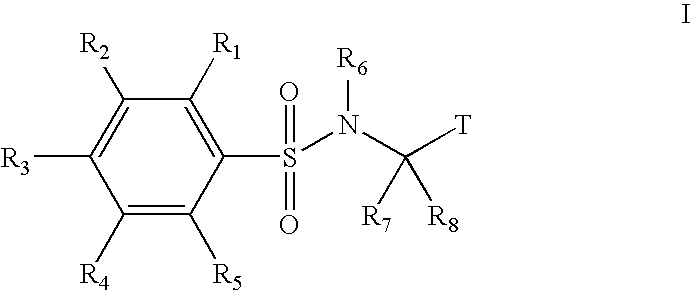Substituted phenylsulfonamide inhibitors of beta amyloid production
a technology of substituted phenylsulfonamide and beta amyloid, which is applied in the field of small molecular compounds, can solve the problems of toxic accumulation of beta amyloid in cell culture, detrimental to memory, and detrimental to the effect of memory
- Summary
- Abstract
- Description
- Claims
- Application Information
AI Technical Summary
Benefits of technology
Problems solved by technology
Method used
Image
Examples
example 1
2-Bromo-N-[(1S,2S)-1-(hydroxymethyl)-2-methylbutyl]benzenesulfonamide
[0219]
[0220] To a solution of (S) isoleucinol (23 mg, 0.2 mmol) in THF (3 mL) was added triethylamine (46 μL, 0.24 mmol) and 2-bromobenzenesulfonyl chloride (51 mg, 0.2 mmol). The solution was stirred for 8 to 16 hours, then concentrated. The residue was dissolved in MeOH (1.5 mL) and purified by semi-preparative RP-HPLC using the following conditions:
[0221] Column: Phenomenex C18 Luna 21.6 mm×60 mm, 5μ
[0222] Solvent A: Water (0.02% TFA buffer)
[0223] Solvent B: Acetonitrile (0.02% TFA buffer)
[0224] Solvent Gradient: Time 0: 10% B; 2.5 min: 10% B; 14 min: 90% B.
[0225] Flow Rate: 22.5 mL / min
The product peak was collected based on UV absorption and concentrated to give Example 1 (37.7 mg).
[0226] The following compounds (Table 1; Examples 1-13) were prepared using 2-bromobenzenesulfonyl chloride, 3-bromobenzenesulfonyl chloride, 3-chloro benzenesulfonyl chloride, 4-chloro-7-chlorosulfonyl-2,1,3-benzoxadiazole, ...
example 14
3-Amino-4-chloro-N-[(1S,2S)-1-(hydroxymethyl)-2-methylbutyl]benzenesulfonamide
[0227]
[0228] A. Preparation of 3-Nitro-4-chloro-N-[(1S,2S)-1-(hydroxymethyl)-2-methylbutyl]benzenesulfonamide
[0229] To a solution of S-isoleucinol (3.0 g, 25.6 mmol), triethylamine (2.85 g, 28.2 mmol) and methylene chloride (30 mL) at 0° C, was added a solution of 4-chloro-3-nitro-benzenesulfonyl chloride (6.55 g, 25.6 mmol) in CH2Cl2 (30 mL). After 15 minutes, the ice bath was removed and the reaction allowed to reach 25° C. After 16 hours, the reaction was quenched by pouring into a saturated sodium bicarbonate solution (125 mL). The organic phase was separated and washed sequentially with 1N HCl solution (100 mL), distilled water and brine, dried over MgSO4 and evaporated to give a crude solid that was recrystallized from ethyl acetate-hexane (5.52 g, 64%). MS (+ESI) 354 ([M+NH4]+). Anal. Calc'd for C12H17ClN2O5S: C, 42.80; H, 5.09; N, 8.32; Found: C, 42.82; H, 5.05; N, 8.23.
[0230] B. Preparation of ...
example 15
N-[(1S)-1-benzyl-2-hydroxyethyl]-4-bromobenzenesulfonamide
[0232]
[0233] To a solution of (S)-(−) 2-amino-3-phenyl-1-propanol (37 mg, 0.25 mmol) in THF (3 mL) was added triethylamine (58 uL, 0.3 mmol) and 4-bromobenzenesulfonyl chloride (63 mg, 0.25 mmol). The solution was stirred for 8 to 16 hours, then concentrated. The residue was dissolved in MeOH (1.5 mL) and purified by semi-preparative RP-HPLC using the conditions described in Example 1 to give Example 15 (9.8 mg). This procedure is outlined in the following Scheme.
TABLE 2(LCMS Data1: Molecular ion and retention time)R1R2NH(S)-(−) 2-amino-3-phenyl-1-propanolExample 15; (372.0 M + H);3.110 min
PUM
| Property | Measurement | Unit |
|---|---|---|
| Mass | aaaaa | aaaaa |
| Mass | aaaaa | aaaaa |
| Mass | aaaaa | aaaaa |
Abstract
Description
Claims
Application Information
 Login to View More
Login to View More - R&D
- Intellectual Property
- Life Sciences
- Materials
- Tech Scout
- Unparalleled Data Quality
- Higher Quality Content
- 60% Fewer Hallucinations
Browse by: Latest US Patents, China's latest patents, Technical Efficacy Thesaurus, Application Domain, Technology Topic, Popular Technical Reports.
© 2025 PatSnap. All rights reserved.Legal|Privacy policy|Modern Slavery Act Transparency Statement|Sitemap|About US| Contact US: help@patsnap.com



